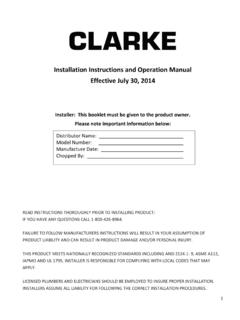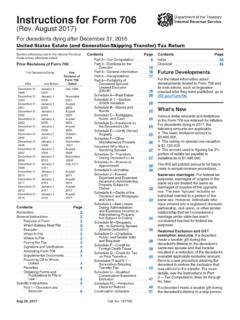Transcription of 2018 Instructions for Form 4684 - irs.gov
1 Userid: CPMS chema: instrxLeadpct: 100%Pt. size: Draft Ok to PrintAH XSL/XMLF ileid: .. ions/I4684/2017/A/XML/Cycle06/source(Ini t. & Date) _____Page 1 of 8 16:14 - 21-Feb-2018 The type and rule above prints on all proofs including departmental reproduction proofs. MUST be removed before for Form 4684 Casualties and TheftsDepartment of the TreasuryInternal Revenue ServiceSection references are to the Internal Revenue Code unless otherwise InstructionsFuture DevelopmentsFor the latest information about developments related to Form 4684 and its Instructions , such as legislation enacted after they were published, go to s NewSpecial rules and updated return proce-dures for claiming qualified disaster los-ses. Personal casualty losses resulting from Hurricane Harvey or Tropical Storm Harvey, Hurricane Irma, Hurricane Maria, and the California wildfires, may be claimed as a qualified disaster loss on your Form 4684.
2 See When To Deduct a Loss, later. Form 4684 has been updated to reflect special relief provided as part of the Disaster Relief and Airport and Airway Extension Act of 2017, the Tax Reform Act of 2017, and the Bipartisan Budget Act of 2018. For more information about claiming relief, see Qualified disaster losses, later. The special relief is described in the Specific Instructions for lines 11 and 15, later. Also see for more information and and reporting casualty los-ses using safe harbor methods. You may be able to use certain safe harbor methods to determine the amount of your personal casualty and theft losses. For more information, see Safe harbor methods for determining casualty and theft losses, caused by certain deteriorating concrete foundations may be treated as casualty loss. Effective for federal income tax returns (including amended returns) filed after November 21, 2017, damage to personal residences resulting from deteriorating concrete foundations caused by the presence of mineral pyrrhotite may be treated as a casualty loss.
3 For more information on this safe harbor provision, see Pub. 547, Casualties, Disasters, and disaster losses. A new Section D has been added to Form 4684 to make an election (or revoke a prior election) to deduct a loss sustained in a disaster area and attributable to a federally declared disaster in the tax year immediately preceding the disaster year (defined later). For disaster years beginning in 2018, this election may be made by completing Section D on the 2017 Form 4684 and attaching it to your return or an amended return for 2017 that claims the disaster loss deduction. See Section D Election To Deduct Federally Declared Disaster Loss in Preceding Tax Year for more information. For more information on disaster assistance and emergency relief for individuals, see of FormUse Form 4684 to report gains and losses from casualties and thefts. Attach Form 4684 to your tax You Can DeductYou can deduct losses of property from fire, storm, shipwreck, or other casualty, or theft (for example, larceny, embezzlement, robbery, and Ponzi-type investment schemes).
4 See Pub. 547 for more your property is covered by insurance, you should file a timely insurance claim for reimbursement of your loss. If you don't file an insurance claim, you can't deduct the full unrecovered amount as a casualty or theft loss and only the part of the loss that isn't covered by your insurance policy is expenses. The related expenses you have due to a casualty or theft, such as expenses for the treatment of personal injuries or for the rental of a car, aren't deductible as casualty or theft for protection against future casualties aren't deductible but should be capitalized as permanent improvements. An example would be the cost of a levee to stop You Can't DeductMoney or property misplaced or lost may not be deducted as a theft of china, glassware, furniture, and similar items under normal damage to property (buildings, clothes, trees, etc.)
5 Caused by termites, moths, other insects, or disease. See Pub. 547 for information on the treatment of deteriorating concrete foundations that contain the mineral decline in market value of stock, caused by disclosure of accounting or other illegal misconduct by the officers or directors of the corporation that issues the stock, that was acquired on the open market for investment. You may be able to deduct it as a capital loss on Schedule D (Form 1040) if the stock is sold or exchanged or becomes completely worthless. See chapter 4 of Pub. 550, Investment Income and Victims of fraudulent investment schemes can claim a theft loss deduction if certain conditions apply. See Losses From Ponzi-Type Investment Schemes, later, for more on ReimbursementIf the amount you receive in insurance or other reimbursement is more than the cost or other basis of the property, you have a gain.
6 If you have a gain, you may have to pay tax on it, or you may be able to postpone the 't report the gain on damaged, destroyed, or stolen property if you receive property that is similar or related to it in service or use. Your basis in the new property is the same as your basis in the old tangible replacement property held for use in a trade or business is treated as similar or related in service or use to property held for use in a trade or business or for investment if:The property you are replacing was damaged or destroyed in a disaster, andThe area in which the property was damaged or destroyed was declared by the President of the United States to warrant federal assistance because of that , you must recognize the gain if you receive unlike property or money as reimbursement. But you generally can choose to postpone all or part of the gain if, within 2 years of the end of the first tax year in which any part of the gain is realized, you purchase:Property similar or related in service or use to the damaged, destroyed, or stolen property, orA controlling interest (at least 80%) in a corporation owning such postpone all of the gain, the cost of the replacement property must be equal to or more than the reimbursement you received for your property.
7 If the cost of the replacement property is less than the reimbursement received, you must recognize the gain to the extent the reimbursement exceeds the cost of the replacement the replacement property or stock is acquired from a related person, gain generally can't be postponed by:Corporations (other than S corporations),Partnerships in which more than 50% of the capital or profits interest is owned by corporations (other than S corporations), orAll other taxpayers, unless the aggregate realized gains on the involuntarily converted property are $100,000 or less for the tax Feb 21, 2018 Cat. No. 12998 ZPage 2 of 8 Fileid: .. ions/I4684/2017/A/XML/Cycle06/source16:1 4 - 21-Feb-2018 The type and rule above prints on all proofs including departmental reproduction proofs. MUST be removed before This rule applies to partnerships and S corporations at both the entity and partner or shareholder details on how to postpone the gain, see Pub.
8 Your main home was located in a disaster area and that home or any of its contents were damaged or destroyed due to the disaster, special rules apply. See Gains Realized on Homes in Disaster Areas, To Deduct a LossDeduct the part of your casualty or theft loss that isn't reimbursable in the tax year the casualty occurred or the theft was discovered. However, a disaster loss and a loss from deposits in insolvent or bankrupt financial institutions may be treated differently. See Disaster Losses and Special Treatment for Losses on Deposits in Insolvent or Bankrupt Financial Institutions, you aren't sure whether part of your casualty or theft loss will be reimbursed, don't deduct that part until the tax year when you become reasonably certain that it won't be you are reimbursed for a loss you deducted in an earlier year, include the reimbursement in your income in the year you received it, but only to the extent the deduction reduced your tax in an earlier Lessee's loss in Pub.
9 547 for special rules on when to deduct losses from casualties and thefts to leased LossesA disaster loss is a loss that occurred in an area determined by the President of the United States to warrant federal disaster assistance and that is attributable to a federally declared disaster. It includes a major disaster or emergency a list of federally declared disasters and disaster areas, see determine the amount to deduct for a disaster loss, you must take into account as reimbursements any benefits you received or which you have a reasonable possibility of receiving from federal or state programs to restore your year. The disaster year is the tax year in which you sustained the loss attributable to a federally declared disaster. Generally, a disaster loss is sustained in the year the disaster occurred. However, a disaster loss may also be sustained in a year after the disaster occurred.
10 For example, if a claim for reimbursement exists for which there is a reasonable prospect of recovery, no part of the loss for which reimbursement may be received is sustained until it can be ascertained with reasonable certainty whether you will be In December 2017, your car was destroyed in severe flooding that TIPoccurred in the area where you live. The area where you lived was designated by the Federal Emergency Management Agency (FEMA) to be eligible for public or individual assistance (or both). You immediately filed a claim for reimbursement with your insurance company. There was a reasonable prospect that you would recover the full amount of your loss. The claim was settled in January 2018 when your insurance company reimbursed you for only half of your loss. The disaster year is 2018 (not 2017 when the loss occurred). Your loss was sustained in 2018 because that s when it became reasonably certain whether you would be reimbursed.
















